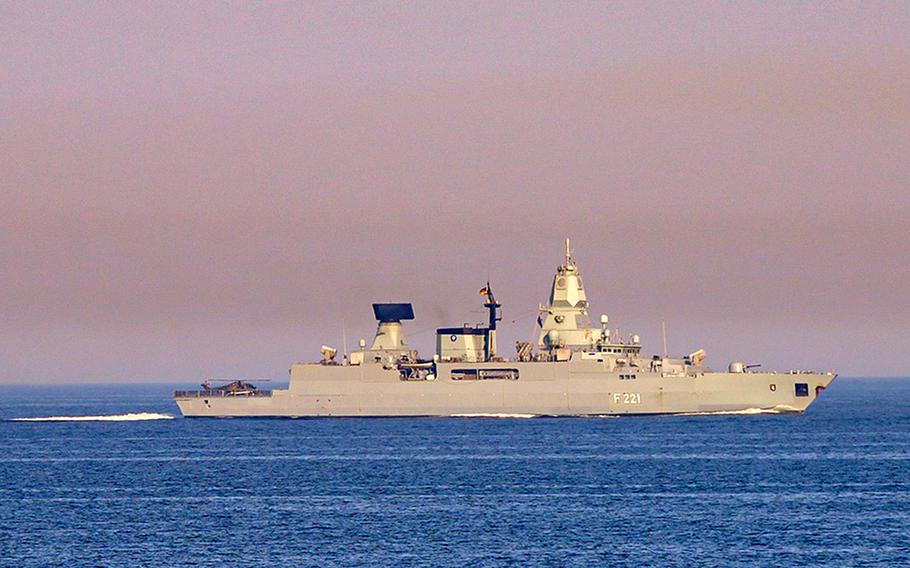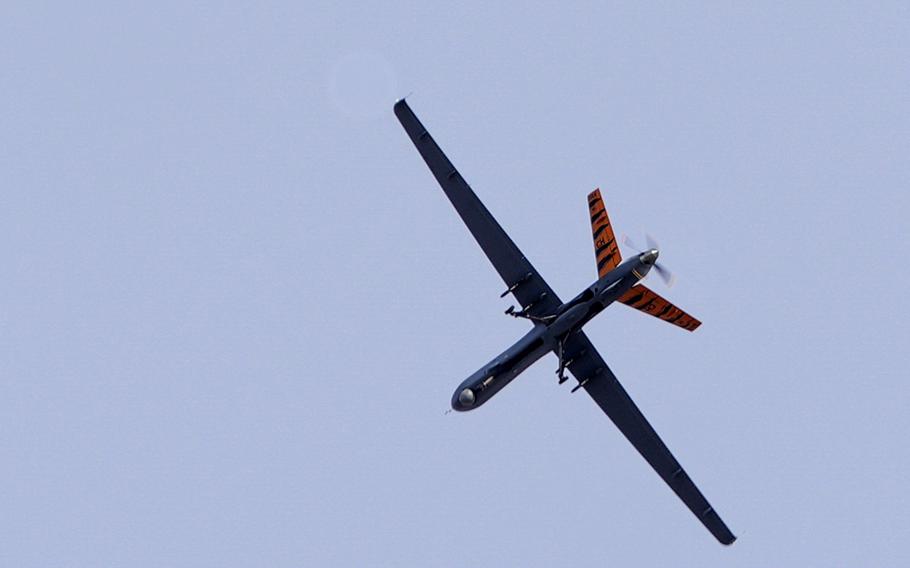
The German frigate Hessen sails during exercise Northern Coasts in the Baltic Sea in September 2023. The German Defense Ministry confirmed on Feb. 28, 2024, that Hessen fired on an allied drone earlier in the week. (Leon Rodewald/German armed forces)
A German navy ship mistakenly targeted a U.S. Reaper drone in the Red Sea earlier this week while operating as part of the European Union’s Aspides mission to protect shipping in the vital waterway, a Defense Department official said Thursday.
The MQ-9 drone wasn’t damaged in the Tuesday incident and continued its mission, the official told Stars and Stripes on condition of anonymity because they weren’t authorized to provide their name.
The targeting of a drone by an ally demonstrates the challenges the U.S. and its partners face in attempting to stem attacks by Iranian-backed Houthi militants, analysts say.
Although the U.S. and other countries operating in the Red Sea are cooperating with each other, the lack of a unified command means information can be incomplete, overabundant or ambiguous, said James Holmes, chair of the maritime strategy program at the Naval War College in Newport, R.I.
“Mistakes are going to happen when a loose naval confederation with no central command takes to the sea to wage war in a high-pressure environment,” Holmes said.
The department was in close communication with the EU and Aspides “to investigate the circumstances that led to this event and to ensure safe deconfliction of airspace,” the defense official said.

An MQ-9 Reaper drone flies over Creech Air Force Base, Nev., Jan. 24, 2024. A Defense Department official confirmed Feb. 29 that a U.S. Reaper was targeted in the Red Sea earlier in the week by a warship that German defense officials said was the frigate Hessen. (Victoria Nuzzi/U.S. Air Force)
The Aspides mission also includes France, Greece and Italy, among other EU countries, and is working in coordination with the U.S.-led Operation Prosperity Guardian.
German Defense Ministry officials identified the ship as the frigate Hessen. The warship shot at the drone when it appeared that the aircraft was not from an allied nation, ministry spokesman Michael Stempfle told the German tabloid Bild on Wednesday.
Hessen later realized the mistake, Stempfle said.
Citing operational security concerns, the ministry did not identify the drone as American or say why Hessen was unable to accurately identify it.
It also wasn’t clear whether the warship’s shots missed the target or self-destructed when Hessen realized that the drone wasn’t from an enemy.
“The statements made by … spokesman Mr. Stempfle stand for themselves and will not be commented on further,” the ministry said in an email response to Stars and Stripes.
Holmes likened the current international strategy in the Red Sea to that used in the Gulf of Aden to combat piracy off the coast of Somalia, where participants coordinated among themselves.
“They could get away with loose cooperation because counterpiracy is a slow-moving affair compared to combat operations, when ship crews often have to decide whether or not to take the shot against an air target within seconds rather than minutes or hours,” Holmes said.
While German and American naval forces operate on the same tactical standards, there is still potential for miscommunication, especially if the operations happen outside a NATO context or mission, said Sebastian Bruns, a German maritime security expert and senior researcher for the Institute for Security Policy at Kiel University.
There are other ways to communicate, but the classified and clandestine nature of military missions preempts them, he noted.
“While these major assets that nations operate in the area are certainly programmed accordingly to avoid blue-on-blue attacks, the potential for miscalculation and misunderstandings is real,” said Bruns, referring to the potential for friendly-fire incidents. “Allies will work to sort these out soon.”
Hessen entered the Red Sea on Friday. Days later, the frigate shot down two Houthi attack drones in what is believed to be the first known use of live weapons in combat by the German navy since World War II.